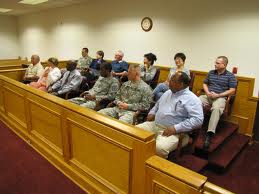There's lots to talk about, but let's take a look at the first of three trial tactic lessons from this film that you can think about adapting to your next trial's Opening Statement for example.
First, the movie starts out near the end of the storyline, a technique worth thinking about the next time you plan your Opening Statement. Many times an attorney will use the Opening to tell the facts of their case as a story, commonly following a chronological storyline of what happened first, then second, and so forth. The theory behind it is that this logical progression through time is an easily recognizable and natural flow for most people to follow and understand because it is the way we live our lives. That's true, but it's not always the most dramatic and riveting way to get someone's attention or to hold it.
The movie is a good example of what we mean. In the movie, in a matter of minutes we are taken to a scene of the heroin's intended act of suicide. Knowing nothing about the character, we are quickly hit with natural questions - all related to how this beautiful woman got to that obviously wrenching point in her life. We want to know more. And that's the whole point of putting the ending at the beginning.
Without knowing that it's the ending, when first observed the viewer is taken aback and, quite often, shocked. How could a movie start with something so shocking and not tell us what led up to this? If this is the start, where is it going? What is going to happen next?
The illogical placement of the movie's "end" at the beginning literally pulls the viewer into the movie. It makes us want to know more because the human mind craves to make sense of the senseless, to make logical that which is illogical. Because of that, this movie pulls you into it from the very start, almost forcing you to ask all the questions that the writer (and director) have yet to answer. And when the viewer hears and sees those answers, it satisfies the uneasy heart with a contentment that is unequaled and ingratiates the viewer to the one who provided those answers (the one who made sense of the world around us).
If you understand that part of human nature, you have an opportunity to take advantage of it in your next trial - because the very illogical nature of it makes it something that most attorneys are ignorant of and ignore even when they are aware of it. The seemingly illogical start of the film is your grand opportunity in a courtroom.
A clever construction of your next Opening could do exactly the same thing to your "viewers" - those people sitting in the jury box. If your chronological story has a dramatic conclusion at its end, then for your Opening Statement think about the possibilities that can open up if you can move the end to the beginning of your Opening instead.
Not only will it take the jury by surprise and draw them into your story, but it will likely strike your opposing counsel as illogical, senseless, and lull them into a complete misperception of what is occurring before their very eyes. With the end at the beginning, they may well perceive your story as confusing the jury - while all the while it is telling the story of your case precisely as you wish it to be, i.e., dramatic, compelling, and enrapturing.
Let’s take an actual wrecked car case (not disclosed at date of sale by local selling dealer). Owner and family are later driving down the road at night, on their way home from out of state family trip, when a deer jumps out and the car hits it, wife screams, kids scream, deer bounces off bumper to hood to windshield and over car, causing damage everywhere it hits. With car on side of road, owner makes sure everyone is okay, his blood pressure and adrenaline goes back down, car towed to the out of town dealer and cab takes them all home. Days later the out of town dealer calls and says we won’t cover the unfixed and badly fixed prior repairs. You can imagine what follows.
Now in a normal sequential opening statement you might start with the first owner’s history of the car, his accidents and repairs, the trade in of it, the reconditioning of it, and the resale of it, and then the client-consumer’s own accident and discovery of the old damage. But putting the ending first would be different. Instead, you would take the most dramatic event (the client’s own accident) and start your opening there and go forward to the owner going down to the out of town dealer and being shown the old accident damage and then jumping back in time to the “beginning” of the car’s history, which is what happened with the original owner having an accident, etc. All your drama comes from your client’s own accident and the shear terror of it. The unexpected twist in the story comes when he finds out there was a prior accident too (insult added to injury).
Not every case has drama, but most probably do. Not every case is amenable to the end of the story being placed at the beginning, but many probably do. Think it over carefully before you dismiss it in your next case.
If you grab your jury's attention at the outset, your opposing counsel may never catch up. And that can mean you (and your client) will have the jury's attention from start to finish. Do it right, and you will win.
Next time, the Second Lesson on what movies teach us about trial tactics. Part 2 coming up.
Ron Burdge
Helping lawyers win cases, for over 30 years.















